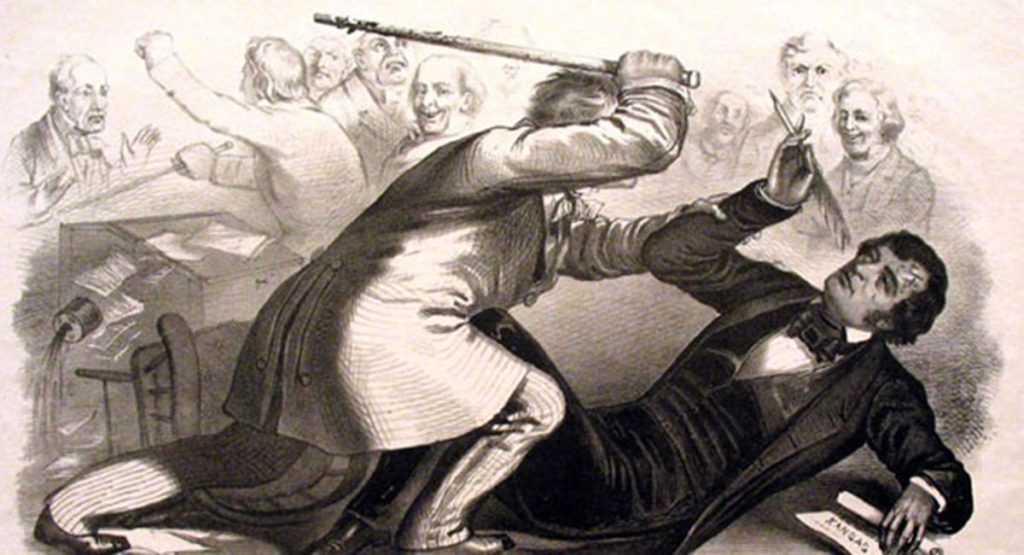It’s Preston Brooks’ World and Sadly We Live In It

I fully expect serious violence on the House floor in the next two years. It will be far from the first time that was a common thing, as Joanne Freeman reminds us.
This is bullying as politics, the modus operandi of our departed chief. Hardly a Trumpian innovation, its heyday was in the decades before the Civil War. During the 1840s and 1850s, America was divided over the fate of slavery. Political parties were splintering under the strain. National institutions were struggling — and failing — to contain it. The press sensationalized the struggle to serve a cause and sell papers. And a new technology spread journalistic hot-takes throughout the nation with greater reach and speed than ever before. The telegraph was the social media of its day, and it came into use in the late 1840s as the slavery crisis was rising toward its peak.
Congressional bullying was useful in those fraught decades, and its practitioners plied their trade proudly; most of them were Southerners, who tended to be armed and ready to fight. Every Congress had its “bullies” who protected slavery with threats and violence, and more often than not, their constituents liked them that way. Some such bullies wore guns and knives in plain view as a warning to game the give-and-take on the floor. Such was the message of weapons in Congress; they were steel-powered attempts to maintain Southern dominance.
…
This Southern strategy of force was no happenstance, no mere matter of custom. Representative Richard Kidder Meade, Democrat of Virginia, declared as much in 1849 on the House floor, bragging that the best way to manage antislavery congressmen was to keep them afraid for their lives. And it worked. Joshua Giddings, a freshman Whig representative from Ohio, was stunned at the sight of it. During his first weeks in Congress in 1838, he saw that Northerners were too “backward and delicate” to confront Southern insolence. “We have no Northern man who dares boldly and fearlessly declare his abhorrence of slavery.”
Not surprisingly, as the slavery debate intensified in the 1850s, so did Southern threats. Representative Thomas Clingman, a Whig from North Carolina, reached new heights during the debate over what came to be known as the Compromise of 1850. If Southern interests weren’t protected, he warned on Jan. 22, Southerners would fight. Their plan of attack was simple, he explained. If fighting with parliamentary gamesmanship like “Northern gentlemen” didn’t get them what they wanted, then they would fight like Southern men — with force. The end result would be a “collision” as electric as the Battle of Lexington, followed by the collapse of Congress.
A few weeks later, Senator Henry Foote, Democrat of Mississippi, made the same threat more subtly, Senate-style. If a South-friendly compromise wasn’t hammered out in the next three days, he declared, the matter would “leave our jurisdiction, and leave it forever.” What did he mean? Newspapers filled the gap. He was threatening armed warfare in Congress.
Would Southerners have opened fire in Congress? Probably not. But could they have? Their track record suggested that they could have, so their threat carried. Concerned congressmen considered outcomes. How many representatives were armed, some wondered. Representative Willie Mangum, another Whig from North Carolina, thought 70 or 80; his fellow North Carolina Whig and friend David Outlaw thought fewer. These men were envisioning warfare in the House, however unlikely it might be.
White supremacists prefer violence as a tactic to ensure their power. It’s at the heart of the ideology. And on this point, there’s very little difference between the Democratic Party of 1855 and the Republican Party of 2021. It’s kind of amazing we’ve reverted to this point. But then it’s also kind of not that surprising. After all, the nation was founded on white supremacy for whatever people want to say about the land of the free and the home of the brave or whatever other buzz words they want to use to describe the United States, this has remained the central ideology of the nation ever since.


